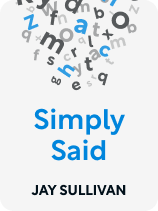

This article is an excerpt from the Shortform book guide to "Simply Said" by Jay Sullivan. Shortform has the world's best summaries and analyses of books you should be reading.
Like this article? Sign up for a free trial here .
What’s the best way to organize a presentation? Should you deliver your point at the beginning or at the end?
If your presentation doesn’t follow a clear structure, your point will likely get lost in the ramble. According to communication expert Jay Sullivan, the author of Simply Said, your should organize your presentation into six parts: 1) opener, 2) conclusion (yes, the conclusion comes second), 3) your premise (what’s in it for them?), 4) supporting evidence (why should they believe you?), 5) recap, and 6) action steps.
Here’s how to structure a presentation to make sure your message gets across.
Create an Organized Presentation
Once you know what you want to say, it’s time to work on how you’re going to present it to your audience. Sullivan says that effective presentations follow a standard format for communicating information: Tell them what you’re going to tell them, tell them, then tell them what you just told them. (Shortform note: This format allegedly originated from Aristotle, the Greek master of rhetoric; 2,500 years later, it’s still being taught.)
In his book Simply Said, Sullivan explains how to structure a presentation in six simple steps:
1) Have a strong opener. Immediately grab your audience’s attention with a problem, a fact, a statistic, a rhetorical question, or a powerful image. For example, if you’re trying to convince management to allow remote work, you can begin your presentation with how much money your department loses as a result of workers’ commutes. This would make a strong opener because it piques the audience’s interest—they would want to know what the relationship is between commuting and the bottom line.
(Shortform note: It’s important to start strong because you only have limited time to set the tone for your presentation—in TED Talks, Chris Anderson writes that you have only about 60 seconds to capture your audience’s attention once you start talking. This is the window of time when the average audience is still listening closely before they start to get distracted. Anderson also says that the first minute of your speech sets the tone for the rest of it, which makes it extra important to get right.)
2) Deliver your conclusion first. Instead of saving your conclusion for last, reveal your recommendation up front. Sullivan says that this keeps the audience from getting impatient and gives them the proper context, making it easier for them to follow the rest of the presentation. Otherwise, they’ll spend the whole time trying to figure out where you’re leading them.
Continuing the previous example, your recommendation can be, “We need to switch to a remote working setup.” (Remember: one sentence with fewer than 10 words.) After you clearly state your recommendation, you can then go into the details: “We will need to establish a dedicated communication channel, set common availability hours, and schedule regular check-ins to ensure that work stays on track.”
(Shortform note: While Sullivan writes that stating your conclusion in the beginning gives your audience a big-picture view of your presentation, saving your conclusion for last can be useful for building suspense. However, this may only be effective in a few scenarios—such as keynote speeches—and in the hands of more seasoned speakers.)
3) Answer: “What’s in it for them?” Stick to Sullivan’s premise of focusing on other people by identifying three to five benefits of your recommendation for your audience. Sullivan writes that the most effective benefits are geared toward the universal motivators of time, feelings, and money. List all these benefits in one slide. For example: “If we switch to a remote working setup, we’ll be able to: 1) increase productivity, 2) allow for more flexible hours, and 3) save on office space expenses.”
(Shortform note: The type of benefits you present may vary depending on the type of thinkers that make up your audience. In The Culture Map, Erin Meyer explains that analytical thinkers—typically Westerners—prefer to know details that directly affect them, while dialectical thinkers—typically Asians—care more about how things impact a broader unit like the company or even the country.)
4) Back up the benefits with data. If you’re using visuals, after stating the benefits on one slide, use succeeding slides to prove that these benefits are real. Sullivan recommends devoting one slide for every benefit mentioned and using statistics, testimonials, or anecdotes to convince your audience that the benefits are evidence-based.
For example: “Increase productivity: Our workers commute an average of 90 hours per year—the equivalent of two-and-a-half working weeks. This results in lost productivity: Since workers have to get up early and get home late, they suffer from disrupted sleep, reduced work-life balance, and more sick days. If we shift to remote work, we may initially experience reduced productivity; however, research shows that after the adjustment period, productivity can increase by as much as 47%.”
(Shortform note: While Sullivan recommends appealing to the audience’s reason with data, others argue that it’s more effective to appeal to their emotion. In Thank You for Arguing, Jay Heinrichs writes that emotions are much stronger than reason and are thus better at motivating people to act. To appeal to an audience’s emotions, Heinrichs recommends telling vivid stories, describing what you felt during an experience without getting overly emotional yourself.)
5) Recap. Following the traditional format, summarize what you just discussed: Reiterate your recommendation and briefly repeat the benefits. (Shortform note: Research supports Sullivan’s advice to restate your recommendation at the end so that people will get your message. This is because of the audience attention curve: While the average audience member may pay close attention to the beginning and end of a presentation, their attention drops by as much as 90% in the middle of it.)
6) Outline action steps. Clearly state the next steps and who’s responsible for them, says Sullivan. This ensures accountability.
For example: “If you approve this recommendation by the end of the month, we will start the transition to remote work by Week 1 of next month. Jeff will coordinate with Maya from IT to set up our cloud-sharing facility and communication channel. In Week 2, I will outline the team’s deliverables and deadlines for the next two months and plot our regular check-in times. In Week 3, Team A will serve as our pilot group and begin working from home. In Week 4, Team A and I will submit a report about what worked and what needs to be improved.”
(Shortform note: Aside from outlining action steps, Sullivan doesn’t give any other recommendation for ending your presentation. In Ted Talks, Chris Anderson says that a great talk can be ruined by a bad closing, so end it on a high note by inspiring your audience with a vision or leaving them with a poetic statement or an eloquent phrase.)

———End of Preview———
Like what you just read? Read the rest of the world's best book summary and analysis of Jay Sullivan's "Simply Said" at Shortform .
Here's what you'll find in our full Simply Said summary :
- A blueprint for effective business communication
- How to create and deliver memorable presentations
- How to write documents and emails that people will actually read






